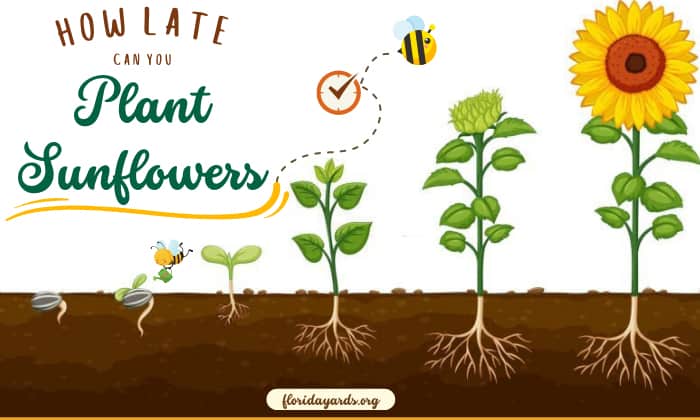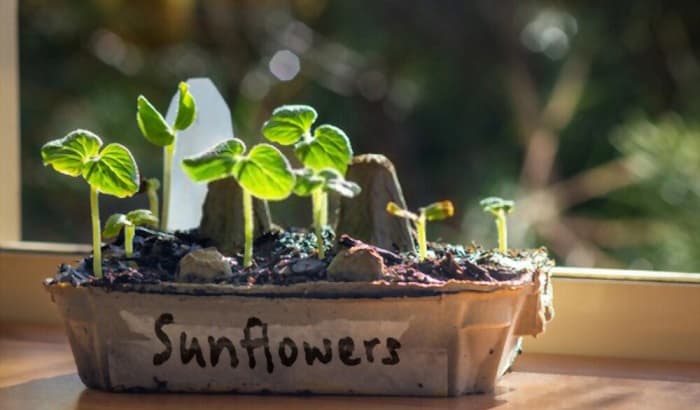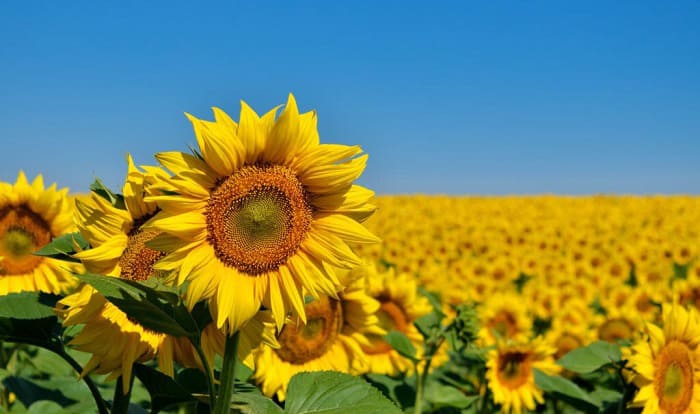Sunflowers love warmth, so it’s only natural that they thrive under mild weather. This is why, if you read gardening guides, you’ll see that the growing season for these plants is late spring.
But what if you forget to plant them then? Do you have to wait until next year to enjoy sunflower blooms?
The answer is no. It’s possible to sow sunflower seeds in summer, up until August and possibly even later, depending on when your fall frost begins.
Read on to know how late can you plant sunflowers.
Table of Contents
How Late to Plant Sunflowers?
When is it too late to plant sunflowers? The answer depends on the sunflower varieties you choose and the first frost where you live. In detail, it is too late to start growing these plants if there isn’t enough time for them to bloom before frost arrives.
To illustrate, if you live in Danville Illinois, your first fall frost will be on October 15.
- Residents who grow Teddy Bear sunflowers in this city will need to do so 65 to 75 days before freezing temperatures come.
- That means planting sunflower seeds on August 1 or 11 at the latest. In this case, sowing seeds in September or mid and late August would be impossible.
Meanwhile, people in Big Rapids, Nichigan will have their expected frost earlier on September 28.
- If they grow Big Smile sunflowers, which take 50 to 60 days to produce bright yellow blooms, their planting times will be August 9 or, to be safe, July 30.
From these examples, it’s clear that if you plant late season sunflowers, it’s best to find the variety with the quickest development, especially if you’re expecting a light frost soon.
Generally, the latest time for planting sunflowers will be in July or late August. You can use 100 days as your benchmark for calculating when to sow seeds, since this is the upper limit of sunflower plants’ maturation period.
Tips for Planting Late Season Sunflowers
Whether you grow sunflowers in late summer or in the fall, you can put them in your garden bed or in pots.
- If you plant sunflower seeds directly into the garden outdoors, you’ll have to follow the rule on early fall frosts we mentioned above. Make sure your sunflowers bloom before winter arrives, or cold weather will kill them.
- In contrast, if you have an indoor yard with temperature control, you can ignore the first frost date and plant sunflowers inside anytime you want. Sow the young seedlings in pots or directly into the garden bed, though I recommend direct seeding, as sunflowers are hard to transplant.
- Alternatively, you can plant seeds in pots outdoors and move them inside before the first early frost date. This way, you won’t have to worry about low air and soil temperatures ruining your yellow flowers.
- In terms of the sunflower planting season, some regions have more extended growing periods than others. Specifically, warmer parts of Australia and other tropical or subtropical regions allow growing sunflowers year-round.
- However, if you don’t live in these climates, remember this: Though sunflowers are cold-hardy down to zone 2, zone 8 and up have better chances of growing these flowering plants during summer.
Frequently Asked Questions
1. When is the best time to plant sunflowers?
Sunflowers growing is best done after the last spring frost if you sow the seeds outdoors. For young plants to survive and sprout, the soil’s temperature should also measure 55 to 60 degrees at the minimum.
Indoor gardening, on the other hand, can begin earlier, about four to six weeks before the last frost date.
These rules apply to both the US and the UK. And if you wonder what month to plant sunflowers in spring, the growing season will often start in March or April in the US and end in June. For the UK, April and May are when people plant sunflowers.
To give you an example, Indianapolis in Indiana has its last frost on April 26. Therefore, residents here can have their sunflowers planted on April 27 outdoors or on March 15 to 29 indoors.
Read more: Best time to plant sunflowers in North Carolina.
2. Where to plant sunflowers or sunflower seeds?
Whether you put sunflowers in the garden or in containers, keep in mind the following criteria when selecting your planting location:
- Place the sunflower seedlings or seeds in well-drained soil with a pH of 6 to 7.5.
- Give them full sun exposure (6 to 8 hours of sunlight per day) and put them in rows that are 30 inches apart.
- Avoid planting in locations with strong winds.
- Pick a spot with fertile soil (i.e., soil rich in nitrogen, potassium, and phosphorus, plus organic matter and other minerals).
3. What happens if you plant sunflowers late?
If you stick to the guideline above, your sunflowers will still grow, though there’s a chance they will have fewer flower heads. You may wonder why this is the case.
As fall and winter approach, the day will get shorter, giving sunflowers less sunlight to absorb. We also know from research that following the sun helps these plants develop and produce bigger leaves, so if you’re deciding when to plant sunflowers, stick to mid or early spring if possible.
4. What are the hardiness zones for sunflowers?
Sunflowers will grow best in hardiness zone 2 to 11. In practice, this means you can plant them in pretty much all parts of the United States, given that the country only has thirteen main hardiness zones.
If you want to know whether your climate is suitable for sunflowers, go to planthardiness.ars.usda.gov and look up the map for your locality.
- For example, if you live in CT or other states in the Northest, you’ll have no trouble growing tall sunflowers, considering you’ll be in zone 3 to 7.
- Places in the Midwest, namely, Ohio, Indiana, and Missouri, can accommodate sunflowers as well because they’re in zone 5, zone 6, and 7.
- Similarly, zone 5 to 8 in Virginia and zone 7 to 9 in Alabama (both Southeast states) all suit sunflower growing.
Using hardiness zones, you can find more examples of places for sowing sunflowers, such as in California. This information can also be used to pick your plant variety since seed packages will usually list the zones or regions they best grow in.
5. Which pests should I look out for when planting sunflowers?
Below are some pests that will attack sunflowers:
- Aphids
- Bugs (such as harlequin and left-footed varieties)
- Sunflower moths (or Homoeosoma ellectellum)
- False and true wireworms
- Thrips
- Loopers
- Field crickets
Conclusion
How late can you plant sunflowers? Hopefully, you now have the answer.
It’s essential to avoid frosts when choosing your planting date. Only by doing so will you have flower petals to decorate your home with and sunflower seeds to use as a tasty snack.
And if you have a bird feeder, know that sunflowers produce edible seeds that attract avians as well.
Have you sowed sunflowers yet? If you haven’t, why not start this year and brighten up your home with vases of cut flowers?

Hi, I am William – Floridayards’ digital content creator. My job is to find answers to all your concerns with thorough research and our team’s expert advice. I will also bring you honest reviews on the best products and equipment for raising your beautiful garden. Please look forward to our work!














